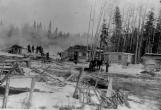16
Edison district was named for the pioneer Edgson family.1902
Unknown
 Credits:
Credits:The Good Old Days 1867-1967
17
In 1902 three Edgson brothers arrived in Edmonton from Thessalon, Ontario. A fourth brother, Frank would follow in the spring of 1903 with the livestock and household effects.They were welcomed by the men of Edmonton who eyed them as another boon to the area. Charles, Jack and Art were neither modest not retiring by nature met with their acceptance.
They were told of available land in various parts of the newly opened Alberta but because they wanted a place where they would have first choice of the homesteads they kept questioning other settlers who were coming and going at the local livery stables.
In April 1902, Charlie Edgson and friend Neil Forbes set out to see the land known as the "Little Grande Prairie". The other Edgson brothers remained in Edmonton working at whatever jobs they could find until Charlie and Neil returned.
19
On the banks of the Saskatchewan River.1903
Edmonton, Alberta, Canada
 Credits:
Credits:The Good Old Days 1867-1967
20
The first settlers after the Quebec families were Arthur, Jack and Charlie Edgson who took homesteads also for their father and younger brother, Frank.With them came a neighbor named Irwin Armstrong. Late that fall three young Scots, George McLachlan, James Curle and Duncan Gray also found land.
"We'll need five quarters for homesteads," they said. "We're four sons and our father. Of course we'll want to buy other land too."
At the Eclipse Livery Stable Charlie was accosted by an Indian (sic).
"Fifty Mile Nort'," said the red man(sic). "Little Grande Prairie. Good land. Not much tree."
Edgson thought nothing of the contradictory adjectives. He had heard of Grande Prairie of the Peace River country. He supposed that this nearer and smaller region must be like it. Like most Canadians then and now he believed in what any Indian told him about land or weather.
"Pass St. Albert, pass Morinville," said the Indian (sic), speaking with the French accent of one of Father Lacombe's Crees. "Pass Bush, maybe five mile. then lots of good land. 'Une Grande Prairie' ."
Then he walked abruptly away and was seen no more.
The Land Office confirmed the Indian's information. There was such a place, it had been surveyed and would be thrown open for homesteading in a month or two."
22
Along the many trails were established "stopping places" where travellers could stop and gather strength and rest their animals after several days travel. The closest stopping place to the Edison district in the early days was the Watt stopping place on the Athabasca Landing trail to the east.Charlie Edgson and Neil Forbes did not travel the Landing Trail however, they took the more arduous but more direct "Bush Trail".
They liked what they saw and returned to Edmonton to arrange for the Edgson brothers and other associates to file on homesteader land. The four Edgson brothers Jack, Charlie, Frank and Arthur - with Paddy (Irwin) Armstrong set out on the trail, reportedly July 12, 1902 ... and what a trail it was!
24
In the years that followed, Mrs. Edgson welcomed many of the new settlers as they arrived and helped them to get established and become part of this new growing community. She was also quick to judge each group as they arrived, determining in her mind if they would become valued members of this new settlement.25
Daphne Garrison is the author of much of the history of this exhibit1920
Edison, Westlock, Alberta, Canada

26
Daphne Garrison was nine when the family came to Alberta. She was a precocious child and an avid reader. She soon started to record important dates and events. Since news was scarce she would list attendance at church and social functions. She also recorded neighborhood attitudes and disagreements, undoubtedly reflecting the views of her parents., She found these early diaries most useful in writing this accountDaphne attended High School in Edmonton, Normal in Calgary, and excepting the few years she taught near home was elsewhere until 1930, when she returned from a year in Chicago. She stayed with her parents on the farm until 1935. That fall she returned to Vegreville High School where she had taught from 1925 to 1929. There she remained until she retired in 1959 to her farm near Westlock (the family farm). She moved to Edmonton in 1977 and died on February 13, 1979.
Until her fatheršs death in 1941 Daphne spent her summers and other holidays on the farm, helping her parents and "catching up" on neighborhood news. She wrote about the early days and collected data on the subject. One of her articles about Edison was published in the Alberta Historical Review, Winter 1962. During her retirement she interviewed many old-timers. She was working on the final draft of her manuscript when her last illness began.
27
Early neighbours in the Edgson house that burned later.1905
Edison, Westlock, Alberta, Canada
 Credits:
Credits:The Good Old Days 1867-1967




